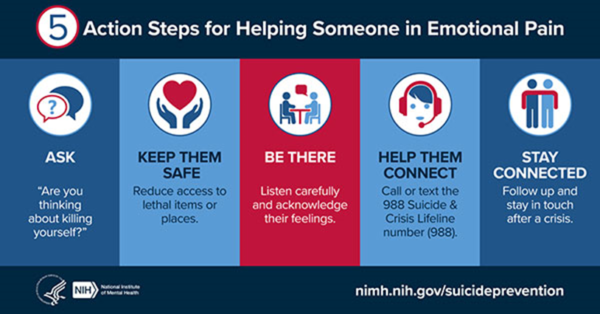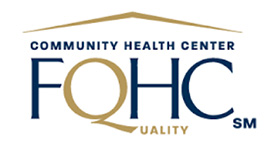Events, Access Health Louisiana Primary Care at Pythian, Belle Chasse C.H.C, Kenner C.H.C., South Broad C.H.C, St. Bernard C.H.C., St. Charles – Norco C.H.C, St. Charles Community Health Center – Luling, St. Tammany – Slidell C.H.C, Tangipahoa C.H.C, Washington C.H.C, Woodworth C.H.C.
Suicide Warning Signs And 5 Steps to Help
If you or someone you know is thinking about or planning suicide, please call 988.
Suicide is a multifaceted issue and there is almost never one explicit reason for why a person is considering ending their life. However, as we bring awareness to this issue, it is important for us to highlight some of the behaviors and signs you may notice in people in your life if they are planning to commit suicide.
There are many different warning signs that someone is considering suicide. If you notice some of these behaviors, we will highlight how you can navigate a conversation with them about their plans and help support them into treatment.

Licensed Clinical Social Worker and Vice President of Behavioral Health for Access Health Louisiana Vanice Zenon, mentions that some of the warning signs for suicide include “being in a state of deep despair: The person talks about feeling hopeless, having no reason to live, being a burden to others, feeling trapped or being in severe emotional pain. Making preparations: The person begins to put their personal business in order. This might include visiting friends and family members, giving away personal possessions, making a will and cleaning up their room or home. Often the person will search online for ways to die or buy a gun. Some people will write a note before attempting suicide.” Some of the warning signs can be noticed in how and what the person is saying. The Center for Disease Control (CDC) mentions that individuals talking about being a burden, showing increased anger or rage, experiencing hopelessness or extreme mood swings can all be warning signs. Additionally, other warning sings can be increased substance use, looking for a way to access lethal means, or talking or posting about wanting to die. For a more expansive list of warning signs about suicide, please visit the CDC’s page found here.
 The CDC and the National Institute for Mental Health are working in partnership with the program #BeThe1To which helps provide resources for individuals to help support people in their lives who may be at risk of suicide. Both the CDC and #BeThe1To suggest 5 steps to help with suicide prevention. The first step in is Ask. #BeThe1To states that asking, “Are you thinking about suicide?” in an unbiased and nonconfrontational way helps a person feel that not only are you open to discussing suicide risk, but you are open to discussing it in a direct and unbiased matter. The second side to this step is to listen. Follow up your questions with questions of “how can I help?” Focus on their answers and try to help them focus on their reasons for living and avoid trying to highlight your reasons for them straying alive. One example of research highlighting how asking at-risk people about suicidal ideation can be found at this link. Zenon adds to this by suggesting that you “praise/thank them for telling you, encourage them that there is help and you can assist them in seeking the proper support. Don’t leave them alone and make sure they are safe by referring them to 988 or call 911.”
The CDC and the National Institute for Mental Health are working in partnership with the program #BeThe1To which helps provide resources for individuals to help support people in their lives who may be at risk of suicide. Both the CDC and #BeThe1To suggest 5 steps to help with suicide prevention. The first step in is Ask. #BeThe1To states that asking, “Are you thinking about suicide?” in an unbiased and nonconfrontational way helps a person feel that not only are you open to discussing suicide risk, but you are open to discussing it in a direct and unbiased matter. The second side to this step is to listen. Follow up your questions with questions of “how can I help?” Focus on their answers and try to help them focus on their reasons for living and avoid trying to highlight your reasons for them straying alive. One example of research highlighting how asking at-risk people about suicidal ideation can be found at this link. Zenon adds to this by suggesting that you “praise/thank them for telling you, encourage them that there is help and you can assist them in seeking the proper support. Don’t leave them alone and make sure they are safe by referring them to 988 or call 911.”
The second step in suicide prevention interventions is Be There. This step can be done in multiple ways, such as physically being there for them or speaking with them more. It is important that you follow through with however you say you are going to support them and find a way to be present for them. Some of the research supporting the idea of “being there” as being crucial in suicide prevention can be tied to Thomas Joiners Interpersonal-Psychological theory of Suicide. This the theory of an individual’s connectedness to others and limiting isolation can help alleviate risk of suicide. The research of his theory can be found here.
Step 3 of the suicide prevention framework is to Keep them Safe. Now that the conversation of suicide is on the table, it is important to try and understand what their plans were and what their safety risks may be. Learning as much as you can about the plan, do they have a plan for how they would kill themselves? What sort of access do they have to their planned method? Learning the answers to questions like these helps you understand their severity and level of imminent danger for this individual. The best way to help someone in the Keep Them Safe part of the process is by supporting them and working to help them put time and distance between them and their chosen method of suicide.
Following keeping them safe, the next way you can support them is by helping them connect. Resources such as 988, the national suicide hotline, help establish safety net connections between these individuals and resources that can help support them in recovery. Help this person develop a safety plan and have them utilize the resources available to them such as hotlines like 988. This step works right into step 5 which is follow up. After the initial conversation with the person and after you’ve connected them with the immediate resources, you should keep in contact and follow up. Whether that be a text, a call, or sending a message, let them know you are this there for them as a support and a resource. This process will help continue their feelings of connectedness and can further help to lessen their risk of suicide. With these phases you can help lessen the suicide risk of people in your life and help establish supportive connections with them. To see the full description of each phase of the plan, visit #BeThe1To’s page and resources found here. For additional information and resources visit the NIMH page or the CDC’s Suicide Prevention page. After calling 988 for immediate risk assessment, you can refer individuals to Access Health Louisiana’s behavioral health services by calling 1-866-530-6111.

